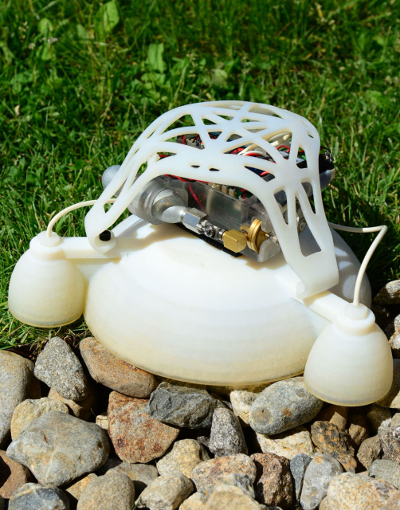3D-printed soft-bots make big leap
 Harvard engineers have unveiled their latest creation - a 3D-printed robot that is soft, rigid and explosive.
Harvard engineers have unveiled their latest creation - a 3D-printed robot that is soft, rigid and explosive.
Researchers around the world are working on a new generation of malleable and pliable robots, using soft materials to limit the chance of damage to the machine and the world with which it interacts.
Most soft robots so far have been slow, complicated and expensive to build, but the new development from the US gets around some of these issues by way of advanced manufacturing techniques.
A team led by research engineer Nicholas Bartlett built the soft, jumping robot out of nine blended layers of 3D-printed materials.
The layers range from soft as rubber to as rigid as metal, making it the first robot to be produced with a gradient of stiffness.
The research has been published in the journal Science.
“3D-printing, right now, opens up a whole new fabrication strategy for soft robotics,” Bartlett says.
“It was also really surprising and encouraging to see just how durable this 3D-printed technique of blending [gradients of material stiffness] made our robot.”
The soft-bot gets around in bold leaps, with each jump powered by an explosion of butane and oxygen. The internal blast rapidly inflates the bottom of the bot's semi-spherical body, thrusting it into the air.
Before a jump, the robot's three rocket engine legs can be inflated with different amounts of air, allowing them to be angled in the direction it needs to jump.
The top of the robot's body features a stiff roll cage covering its internals, which includes a battery, computer, pump, and tanks of butane and oxygen.
One of the big breakthroughs comes from the fact that everything other than the robot's stiff components is 3D-printed as a singular piece.
Separate appendages are attached via just four tubes, which carry air to inflate the legs, deliver fuel and spark the fuel's ignition.
The simple setup makes the small jumper easy to fabricate, and able to leap more than 6 times its height. Even better, when it lands at odd angles its softness allows it to continue without being harmed.
Bartlett built the bot on a Stratasys Connex 500 3D printer, using two materials “mixed at different ratios to form a 9-layer spectrum from completely rigid to completely soft,” he told reporters.
He said it was not exactly a unique design.
“If you take something like an octopus, an animal with an entirely soft body and rigid beak, you find that there's not an abrupt change between the two materials, but a gradual transition,” Bartlett said.
Cornell University roboticist Robert Shepherd - who was not involved in the new research but produced one of the first explosion-powered soft robots back in 2012 - says Bartlett’s bot “is a really elegant use of 3D printing, and I was very excited to see all the improvements they've made through utilizing this interesting [material-gradient] technique”.
Shepherd says using 3D-printers gives it a real democratising element.
“There's a very low barrier to entry for anyone who wants to play around with and create these soft robots easily and rapidly,” he says.
“That's a big deal, because when something that previously required an expensive process is suddenly accessible to a large amount of interested people, you can expect huge improvements in the technology.”
Have a look at the robot in action in the video below;








 Print
Print